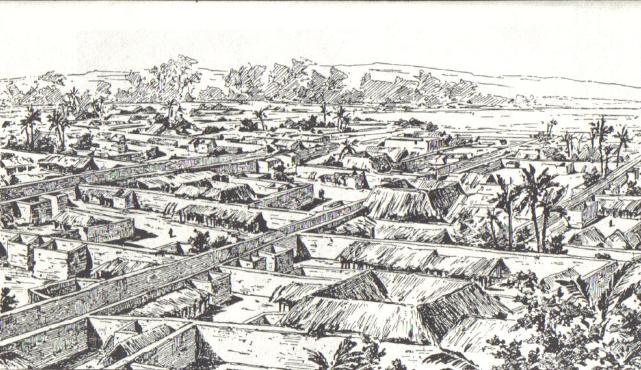|
Benin City
Benin City is the capital and largest city of Edo State, Nigeria. It is the fourth-largest city in Nigeria according to the 2006 census, after Lagos, Kano, and Ibadan, with a population estimate of about 3,500,000 as of 2022. It is situated approximately north of the Benin River and by road east of Lagos. Benin City is the centre of Nigeria's rubber industry, and oil production is also a significant industry. The city was the most important settlement of the Edo Kingdom of Benin, which flourished during the 13th to the 19th century. It held important trade relations with Portugal during the last centuries before being captured, sacked and burnt in 1897 by a British punitive expedition. Many bronze sculptures in Benin City palace, collectively termed the Benin Bronzes, were taken by the British who followed up their victory by gradually colonizing the area, eventually incorporating the region into Colonial Nigeria. The indigenous people of Benin City are the Edo peopl ... [...More Info...] [...Related Items...] OR: [Wikipedia] [Google] [Baidu] |
Benin
Benin ( , ; french: Bénin , ff, Benen), officially the Republic of Benin (french: République du Bénin), and formerly Dahomey, is a country in West Africa. It is bordered by Togo to the west, Nigeria to the east, Burkina Faso to the north-west, and Niger to the north-east. The majority of its population lives on the southern coastline of the Bight of Benin, part of the Gulf of Guinea in the northernmost tropical portion of the Atlantic Ocean. The capital is Porto-Novo, and the seat of government is in Cotonou, the most populous city and economic capital. Benin covers an area of and its population in was estimated to be approximately million. It is a tropical nation, dependent on agriculture, and is an exporter of palm oil and cotton. Some employment and income arise from subsistence farming. The official language of Benin is French, with indigenous languages such as Fon, Bariba, Yoruba and Dendi also spoken. The largest religious group in Benin is Sunni Isl ... [...More Info...] [...Related Items...] OR: [Wikipedia] [Google] [Baidu] |
Art Of The Kingdom Of Benin
Benin art is the art from the Kingdom of Benin or Edo Empire (1440–1897), a pre-colonial African state located in what is now known as the Southern region of Nigeria. Primarily made of cast bronze and carved ivory, Benin art was produced mainly for the court of the Oba of Benin – a divine ruler for whom the craftsmen produced a range of ceremonially significant objects. The full complexity of these works can be appreciated through the awareness and consideration of two complementary cultural perceptions of the art of Benin: the Western appreciation of them primarily as works of art, and their understanding in Benin as historical documents and as mnemonic devices to reconstruct history, or as ritual objects. This original significance is of great importance in Benin. Importance of Art in Benin Culture The Kingdom of Benin was powerful, but Benin culture has not been given proper recognition by western scholars. The story of how the Kingdom of Benin began as a culture and na ... [...More Info...] [...Related Items...] OR: [Wikipedia] [Google] [Baidu] |
Ifẹ
Ifẹ̀ ( yo, Ifẹ̀, also ''Ilé-Ifẹ̀'') is an ancient Yoruba city in south-western Nigeria. The city is located in present-day Osun State. Ife is about 218 kilometers northeast of Lagos with a population of over 500,000 people, which is the highest in Osun State according to population census of 2006. According to the traditions of the Yoruba religion, Ilé Ifè was founded by the order of the Supreme God Olodumare by Obatala. It then fell into the hands of his brother Oduduwa, which created enmity between the two.Bascom, ''Yoruba'', p. 10; Stride, Ifeka: "Peoples and Empires", p. 290. Oduduwa created a dynasty there, and sons and daughters of this dynasty became rulers of many other kingdoms in Yorubaland.Akinjogbin, I. A. (Hg.): ''The Cradle of a Race: Ife from the Beginning to 1980'', Lagos 1992 (The book also has chapters on the present religious situation in the town). The first Oòni of Ife is a descendant of Oduduwa, which was the 401st Orisha. The present ru ... [...More Info...] [...Related Items...] OR: [Wikipedia] [Google] [Baidu] |


